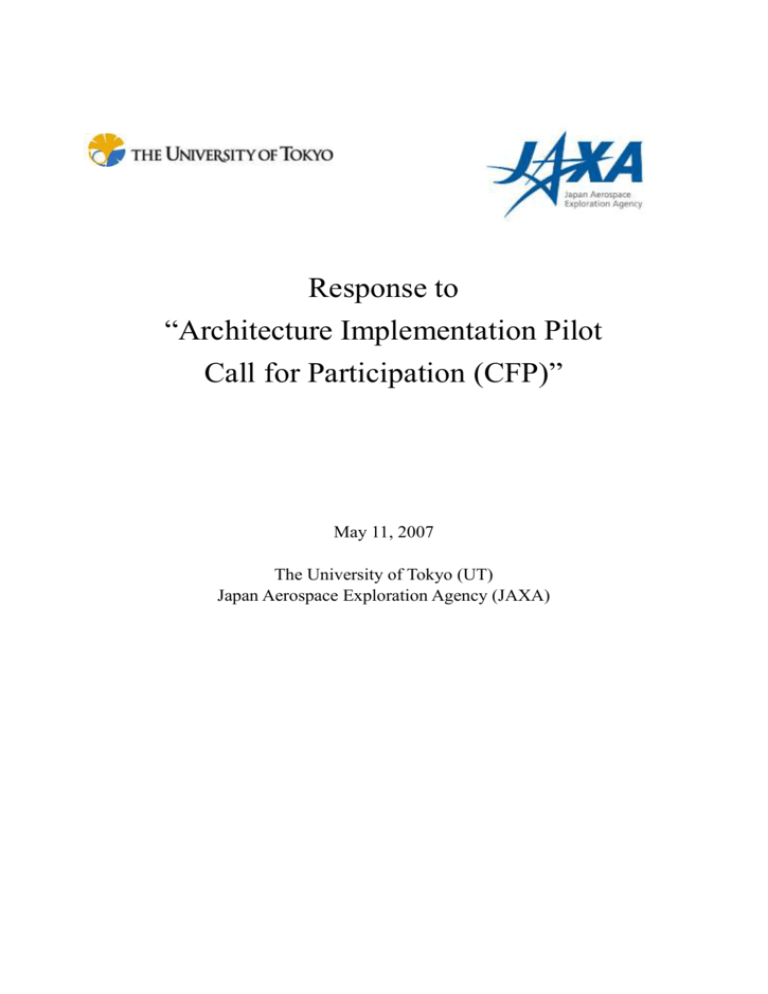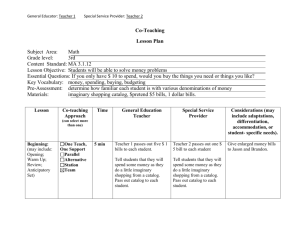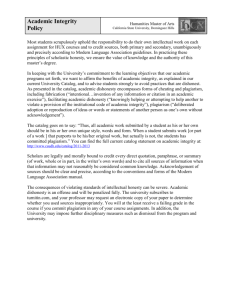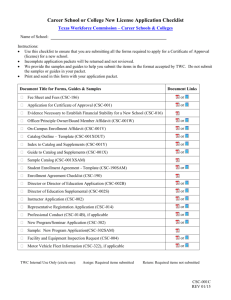CFP_response_UT_JAXA
advertisement

Response to “Architecture Implementation Pilot Call for Participation (CFP)” May 11, 2007 The University of Tokyo (UT) Japan Aerospace Exploration Agency (JAXA) 1. Overview (1) Offered Components Catalog services and on-line access (WCS) for JAXA Earth observation satellite data are offered. This enables an ISO19115(19139) compliant view of the various collections (dataset series) of satellite data and also provides WCS 1.0.0 to show Earth Observation images. (2) Contribution to SBA Those data will be beneficial to “Reduction and Prevention of Disasters”, “Climate Change”, “Water Management”, “Weather Forecasting”, “Ecosystems”, “Agriculture” and “Biodiversity” (3) Current Status Both of Catalog services and on-line access (WCS) will be ready for testing by the Kick Off meeting in June, 2007. 2. Proposed Contributions 2.1. Demonstration Scenario Development (1) Define Scenarios that can be supported by the architecture defined in Annex B. Disaster: Wildfires & Tanker oil spill, Climate Change: Local effects, Ecosystems and biodiversity: Africa & Polar (2) Delineate aspects of the existing Annex B scenarios to which you propose to contribute. We can provide the following services; ALOS Emergency Observation via International Charter "Space and Major Disasters" (Disaster Scenario only) [*For demonstration, this will be simulated.] Catalog Services for Satellite data (e.g.,ALOS, TRMM/PR, Aqua/AMSR-E) Web Coverage Service (WCS) for Satellite data (e.g.,ALOS, TRMM/PR, Aqua/AMSR-E) (3) Provide comments on the Annex B architecture to increase the expectation that the results will support Societal Benefit Areas (SBAs). 1 We suppose a disaster scenario, based on an actual disaster, especially memorable huge disaster, will be more impressive. Scenario’s target areas are almost limited to Africa region. Is it desirable to include other regions? (please see 2.1 (6)) (4) Describe participation and/or membership of the responding organization in SBA activities; list relevant experience for SBAs the organization is offering to participate in, (i) Reduction and Prevention of Disasters As of April, 2007, JAXA has provided satellite image (mainly ALOS) to International Charter "Space and Major Disasters" more than 10 times. Available satellite data and examples via Catalog Service or WCS : High resolution optical sensor and L-band SAR observation for landslide, tsunami, flood and other disasters. (ii) Climate Change Available satellite data and examples via Catalog Service or WCS : Moderate resolution global data to detect change of ice covered area (iii) Water Management Available satellite data and examples via Catalog Service or WCS : Microwave sensor data to observe precipitation and amount of water vapor (iv) Weather Forecasting Available satellite data and examples via Catalog Service or WCS : Microwave sensor data to observe precipitation and amount of water vapor (v) Ecosystems Available satellite data and examples via Catalog Service or WCS : Moderate resolution global dataset for change of vegetation and land cover (vi) Agriculture Available satellite data and examples via Catalog Service or WCS : Moderate resolution global dataset for change of vegetation and land cover (vii)Biodiversity Available satellite data and examples via Catalog Service or WCS: Moderate resolution global dataset for change of vegetation and land 2 cover (5) Define plans for participating in the Pilot Activities regarding scenario development and the application of the scenarios to component integration and demonstration. We plan to participate in the Kick-off meeting in June and attend Scenario development session. After that we will adjust our components (catalog service and WCS) to fit in to the defined scenario. Our data via catalog server and WCS are applicable to all the scenarios in Appendix B (please see 2.1.(4)). (6) Proposal on the new scenario The following scenario is based on the actual disaster, a huge landslide on the Island of Leyte on the west point of the Islands of the Philippines occurred on February 17, 2006. At least two hundred deaths and 1,500 people are missing, according to the Red Cross. Context Incident : Land slide due to heavy rain in the Philippines Actors : Emergency On-Call Office (ECO) and many different thematic service providers. Mission : Evaluate the areas of the landslide, probability of re-occurrence, damage level / area ( damage to infrastructure and habitat region, specify land use type) Evaluate the landslide Supply to ECO an evacuation plan which can lead people in a certain district to another district, and other needed and effective information that will help ECO to make an easy understandable evacuation plan immediately. Obtain information of precipitation or weather condition until the landslide occurred to make the best use of the lessons to prevent similar disasters in the future. Field activities : Radar and optical EO (incl. Emergency observation) Precipitation Weather conditions 3 Simulation Supply/collect related information ( e.g., map of soil (to see how a district is tolerant to precipitation), population density, land use type, etc.) Incident The ECO is alerted from a huge landslide occurred in the Philippines 1st step He requests emergency observation of Earth observation satellites. nd 2 step He wants to discover which data, products and services are available for this area of interest and this thematic. He connects to the GEO web portal (TBD). rd 3 step After having identified some interesting products for his needs, he does a catalogue search of these products to have quicklook and more information. 4th step He orders the identified products previously directly to the providers. 5th step He does a feasibility check to know if he would be able to have better products. 6th step He receives the products (via emergency observation and GEO portal) from the provider via FTP protocol or WMS/WCS through an orchestrated chain. th 7 step He evaluates disaster area by comparing two EO images obtained before disaster occurs and after it. He maps the EO products in the viewer overlapping with other information, for example, position of buildings that are available as refuges, infrastructures such as roads, land use type, soil and population density, by using WCS. End state He has all the needed information to help him to take the good decision for evacuation plan and effective related information to make an evacuation plan. He obtains information of precipitation or weather condition until the landslide occurred to make the best use of the lessons to prevent similar disasters in the future. 4 2.2. Component and Service Contributions (1) Descriptions of the components and services to be contributed, (i) Components to acquire observations (e.g.) ALOS emergency observation [*For demonstration, this will be simulated.] (ii) Components to process data into useful information Catalog service Web coverage service (2) Relationship of the components and services to the architecture in Annex B. Comments to support the refinement of the Annex B architecture are encouraged, Catalog service and WCS for Earth observation data collected by JAXA will be provided. (3) Examples of which Societal Benefit Areas that the components and services support, e.g., relevant data, processing capabilities and/or client applications, Regarding supporting SBAs, please refer 2.1 (4). (4) Support of open standards by the components, Provides an ISO19115(19139) compliant view of the various collections (dataset series) of satellite data provided by JAXA. Supporting catalogue service protocol will be OGC CSW 2.0.1, and using application profile of OGC CSW 2.0.1 AP ISO19115/19119. Provides OGC:WCS 1.0.0 to show EO images by JAXA (5) Performance capability of the components including typical traffic (hits per hour) that the components support The catalogue is supported using the ESRI ArcIMS catalog server. Performance depends on ArcIMS. WCS is supported using UMN MapServer. Performance depends on MapServer. (6) Availability of the components for participation in the Pilot activities including persistent demonstration. Our components will be operated 24 hours every day except maintenance time. 5 3. Description of Responding Organization 3.1. The University of Tokyo (UT) Center for Spatial Information Science, the University of Tokyo was established in 1998, and became a national research center in the field of geo-spatial information technology in 2004. 3.2. Japan Aerospace Exploration Agency (JAXA) JAXA was established on October 1, 2003, by merging the Institute of Space and Astronautical Science (ISAS), the National Aerospace Laboratory of Japan (NAL) and the National Space Development Agency of Japan (NASDA) into one independent administrative institution. As a core organization for aerospace technology in Japan, one of the members of GEO, JAXA will promote consistent activities, from basic research to technology development and utilization. JAXA will also pursue the enormous possibilities in space and aviation, and challenge various research and development fields in the aim of "Sustainable Development" in order to contribute to peace and happiness for all mankind. In JAXA, two engineers from Earth Observation Research Center (EORC) were assigned to this project with supports from contractor company (five engineers from Fujitsu Limited), although these seven members do not work on this project at full time. Regarding system resources, the followings are the system specification. i) Catalog Server HW : Sunfire V240 (2GB memory, 145GB Disk) OS : Solaris10 SW: ArcSDE V9.2, ArcIMS V9.2 ii) WCS HW : Xeon 3.2GHz, 2CPU, 2GB memory, 800GB Disk OS : RedHatLinux ES 3.0 SW: UMN MapServer 3.3. Point of Contact (both for Programmatic and Technical) Satoko Horiyama MIURA (Ms.) Earth Observation Research Center / JAXA 6 Phone: +81-29-868-4461 FAX: +81-29-868-5987 E-mail : miura.satoko@jaxa.jp 7






